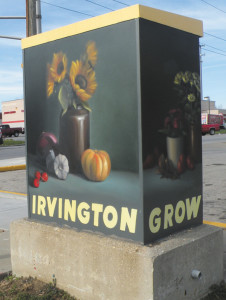If you’ve driven on Arlington, East Washington. East 10th, or Brookville Road recently, you probably noticed the dull grey/green signal boxes have been transformed into works of art. You can thank Foundation East and five very talented artists for brightening your commute.
Aaron Story, the organizer behind Foundation East, said that he was inspired to continue the signal art boxes created in October of last year, when some boxes were painted along East Washington Street as part of a beautification project that also has a crime prevention component. The “broken window” theory of crime prevention — cleaning up neighborhoods and fixing every broken window reduces crime by showing criminals a neighborhood is cared for — is one step in solving urban neighborhood challenges.
“It was a doable project,” he said. “They had a great response last year.” He was also inspired by his involvement with the 5 x 5 Project, which he pitched to help bring more public art to the east side. “I saw that people wanted to support public art here. That was the beginning.”
He formed Foundation East with the idea of being part of a larger conversation about creating community through the arts. Working closely with neighborhood organizations to get permission to paint more signal boxes, particularly the Irvington Development Organization, made the task of expanding the program easier. Then this October he put out a call to artists who might be interested in painting; of the entrants, five were selected: Dave and Holly Combs, Rita Spalding, Andrew Severns, Shelby Kelley, and Erin Swanson Kelsch. Together, they painted 12 more boxes in Irvington, using the themes of “farms and gardens” near where the old Ellenberger family farm was located, and “cars” along Brookville Road and its many connections to the auto industry. The artists were selected not just for their talent, but their willingness to share and engage in the community. “Being an artist isn’t enough.” Artists who live on the east side, or had strong east side connections, were given preference in the selection process.
Vishant Shah, who works with Story closely on the project, noted that the first stage of artwork was so well-received that it opened up many possibilities for people to see the east side as more than “a concrete jungle. It has drawn a lot of attention.”
Artists working on the boxes have all reported that people have pulled over to talk with them about their art, the area, and their lives. There have been powerful emotional exchanges between artists and the neighbors, Story said, including a conversation between an artist and the friend of a person killed in a car accident near one of boxes on Brookville Road. Andrew Severns, who painted two boxes along Brookville said that strangers have approached him with art-related jobs. “Somebody stopped and gave me $5,” he said, laughing. “That was great.” Severns, whose work can be seen at the Art Bank on Mass Ave. usually works in geometric patterns, but found a new artistic challenge with incorporating his unique viewpoint with images of autos.
Story said that painting the signal boxes is just the first step for Foundation East. “We are open to partnering with other organizations on the east side to bring public art to the east side. There is an obvious need here.” He hopes to expand the program to public sculptures and public paintings elsewhere. “This brings artists together, and attracts Millenials and others to the area. It’s a huge benefit.”
For more information about Foundation East, visit their Facebook page, or visit aaronstory.com




